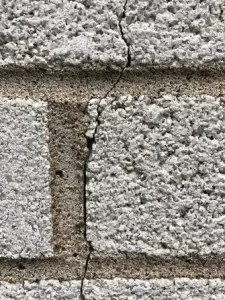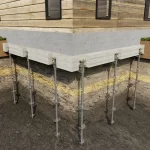What Are the Signs of Foundation Issues?
Foundation issues can reveal themselves through a variety of symptoms, each signaling potential trouble beneath the surface. Cracks in exterior or interior walls, gaps between windows and walls, and floors that squeak or sag are all telltale signs. Homeowners might also notice cabinets separating from walls or doors that stick unexpectedly. Ignoring these signs can lead to severe structural damage, but what exactly causes these problems, and how can one address them effectively? Understanding the underlying reasons is essential for maintaining a safe and stable home environment.
Key Takeaways
– Cracks on exterior and interior walls, floors, or the chimney structure.
– Gaps between windows, walls, or cabinets separating from walls.
– Squeaking, sagging, or bouncing floors.
– Sticking doors and uneven home levels.
– Water leaks, mold, or mildew around the chimney or home foundation.
Exterior Wall Cracks

Spotting exterior wall cracks can be one of the earliest indicators of foundation issues in a home. These cracks often result from foundation settling, which occurs as the soil beneath the foundation shifts or compresses over time. Weathering effects like rain, wind, and temperature changes can exacerbate these shifts, further compromising the structural integrity of the building.
Homeowners should be vigilant in identifying these cracks, as they can lead to more severe problems if left unaddressed. Depending on the severity and location of the cracks, various repair solutions are available. For minor cracks, filling them with epoxy or polyurethane injections can suffice. However, more significant issues might require underpinning or wall anchors to stabilize the foundation.
Preventative measures can also play a pivotal role in maintaining the health of a home’s foundation. Regularly inspecting the exterior walls, ensuring proper drainage around the foundation, and addressing any signs of water pooling can prevent further damage. By taking these steps, homeowners can safeguard their property against the costly and potentially dangerous consequences of foundation issues. Understanding these aspects allows for timely interventions, preserving the home’s value and safety.
Interior Wall Cracks
Identifying interior wall cracks is vital for diagnosing potential foundation issues early. When foundation settling occurs, it can lead to visible cracks in the interior walls of a home. These cracks compromise wall integrity and may signal deeper structural problems. Homeowners should pay attention to their shape, size, and location. Vertical cracks might be less worrisome, often caused by natural settling. However, diagonal or horizontal cracks could indicate more severe issues affecting structural stability.
Moisture damage is another key factor to take into account. Water infiltration can weaken walls, leading to cracks and other visible damage. It’s important to address any moisture problems promptly to prevent further deterioration. Inspecting for signs of water damage near wall cracks can help in identifying the root cause of the issue.
Repair solutions vary based on the severity of the cracks. Minor cracks might be resolved with simple patching and repainting, but significant cracks could require professional intervention. Foundation experts may recommend underpinning or wall anchoring to restore structural stability. Ultimately, addressing interior wall cracks promptly ensures the home’s structural integrity remains intact and prevents more expensive repairs down the line.
Floor Cracks
Floor cracks are a common indicator of potential foundation issues that homeowners shouldn’t ignore. They often signal foundation settling, which occurs when the ground beneath a home shifts or compacts unevenly. This settling can lead to visible slab cracks on concrete floors, particularly in basements and garages.
Basement leaks can also contribute to floor cracks. Water infiltration weakens the concrete, resulting in deterioration over time. When homeowners notice water stains or dampness alongside cracks, it’s essential to address both the leaks and the structural damage to prevent further problems.
Concrete deterioration is another culprit behind floor cracks. Over time, concrete can break down due to age, environmental factors, or poor initial construction. As the material weakens, it becomes more prone to cracking under pressure or shifting soils.
Additionally, wall bowing is often associated with floor cracks. As walls bow inward due to external pressure or foundation settling, the floors can crack from the added stress. Monitoring wall and floor conditions together can provide a clearer picture of underlying foundation issues.
Window and Wall Gaps

Gaps between windows and walls often indicate underlying foundation issues that need immediate attention. These gaps can result from foundation settlement, which causes the structure to shift unevenly. When a foundation settles, it disrupts the original alignment of window installation, leading to noticeable separations.
Addressing these gaps is important as they can compromise wall insulation, making the home less energy-efficient. Poor insulation can lead to higher utility bills and an uncomfortable living environment. Additionally, these gaps can allow moisture to seep in, potentially causing mold and mildew, which deteriorates both the wall’s structure and indoor air quality.
Exterior painting might temporarily mask the problem, but it won’t solve the root cause. A thorough inspection and proper foundation repair are necessary to prevent further damage. Ignoring these issues can also affect the home’s interior design. Walls may crack or bow, and the overall aesthetic of the home might suffer.
Homeowners should seek professional help to guarantee the integrity of their home’s foundation. A structural engineer can assess the extent of the damage, and a licensed contractor can provide the necessary repairs to restore the home’s stability.
Cabinets Separating
Cabinets pulling away from the walls can be an alarming indicator of foundation issues that shouldn’t be ignored. When cabinets begin to separate, it’s often a sign that the foundation support is compromised. This problem directly affects cabinet alignment, making them appear crooked or misaligned. Such misalignment not only disrupts the visual appeal of the kitchen or bathroom but also points to deeper issues with wall stability.
Countertop connections may also show signs of distress. When the foundation shifts, countertops can pull away from the walls, leaving noticeable gaps. This separation reduces the structural integrity of the entire setup, making it difficult to perform everyday tasks safely and efficiently.
One should pay close attention to these signs as they can indicate more serious problems beneath the surface. For instance, cabinets and countertops are often securely fastened to the walls. If they’re pulling away, it suggests that the underlying foundation isn’t providing adequate support, potentially leading to further damage if left unaddressed.
Squeaking Floors
Squeaking floors often signal underlying foundation issues that demand immediate attention. When floors squeak, it usually means there’s friction between the floorboards and subfloor, which can indicate movement in the foundation. This movement can be due to settling, shifting soil, or moisture problems. Addressing these issues promptly is essential to prevent more severe structural damage.
One effective floor repair technique involves floor reinforcement, which strengthens the floor system to handle the stress caused by foundation movement. Floor leveling may also be necessary to correct any unevenness that contributes to the squeaking. During this process, professionals might use shims or other materials to make sure the floor is even and stable.
A thorough floor inspection checklist should include checking for gaps between floorboards, examining the condition of the subfloor, and looking for signs of moisture damage. Regular floor maintenance tips include tightening loose floorboards, using talcum powder to reduce friction temporarily, and monitoring any changes in the floor’s condition.
Sagging Floors
Sagging floors often indicate severe underlying foundation problems that require immediate professional attention. When floors start to dip or sag, it’s a clear sign that the structural integrity of the home is compromised. The issue often stems from weakened support beams or shifting soil beneath the foundation, which undermines foundation stability. Homeowners should not ignore these symptoms, as they can lead to more extensive damage over time.
To address sagging floors, professionals typically assess the need for floor reinforcement. This process may involve adding extra support beams or using jacks to stabilize the affected areas. Ensuring proper floor leveling is essential to restore the home’s safety and functionality. By reinforcing the weakened sections, experts can prevent further sagging and maintain the overall structural integrity of the property.
Moreover, addressing sagging floors promptly helps to preserve the foundation stability, preventing more severe issues down the line. Regular inspections and timely repairs are essential for maintaining a safe living environment. Homeowners should seek professional evaluations to determine the best course of action, ensuring that their home remains sturdy and secure. Ignoring sagging floors can lead to costly and extensive repairs in the future.
Bouncing Floors
Bouncing floors often signal underlying foundation issues that demand prompt attention to prevent further structural damage. When floors feel springy or uneven, it’s a clear indication that something is wrong with the home’s structural stability. The problem usually stems from compromised floor support, which can lead to significant issues if not dealt with promptly.
Sub-floor integrity is vital for maintaining a stable and safe living environment. Weak sub-floors can result in bouncing or sagging floors, which may worsen over time. Homeowners should not overlook these signs, as they can escalate into more severe foundation problems. Immediate foundation reinforcement is necessary to strengthen the weakened areas and secure long-term stability.
Professional inspection and repairs are necessary for addressing such issues. Experts can assess the extent of the damage and recommend appropriate solutions, such as adding floor support or reinforcing existing structures. In some cases, home leveling might be necessary to correct any unevenness and restore the home’s balance.
Uneven Home Levels
Uneven home levels often indicate a serious foundation problem that demands immediate attention to prevent further structural damage. When a home exhibits signs of foundation settling, it’s vital to address the issue promptly to maintain home stability. One of the most noticeable symptoms is sloping floors, which can create a structural imbalance throughout the house. This imbalance not only affects the aesthetic appeal but also poses a safety risk for the occupants.
An uneven foundation often results in one side of the home being lower than the other, causing a noticeable tilt. Homeowners might observe that furniture and other objects don’t sit level, or doors and windows might stick or swing open on their own. Such symptoms are clear indicators that the foundation has shifted or settled unevenly.
Ignoring these signs can lead to more severe problems, including cracks in walls and floors, and even potential collapse in extreme cases. Hence, it’s essential for homeowners to regularly inspect their property for uneven home levels and other related issues. Seeking professional help from a structural engineer or foundation specialist can ensure the problem is correctly diagnosed and efficiently repaired, preserving the home’s integrity and value.
Mold or Mildew
Mold or mildew smells in a home can signal underlying foundation issues that require immediate attention. These odors often result from excessive moisture seeping into the foundation, creating an ideal environment for mold and mildew growth. Effective moisture control is critical to preventing these problems.
Unchecked mold and mildew don’t just damage property; they pose significant health risks. Prolonged exposure can lead to respiratory issues, allergic reactions, and other health problems. To mitigate these risks, homeowners should implement prevention tips such as maintaining proper drainage around the foundation, ensuring gutters and downspouts are functioning correctly, and using dehumidifiers in damp areas like basements.
A professional inspection is essential when mold or mildew smells are detected. Experts can identify the source of moisture and assess any foundation damage. If issues are found, remediation methods will likely involve repairing cracks, improving drainage, and possibly waterproofing the foundation to prevent future problems.
Addressing mold and mildew promptly not only safeguards health but also preserves the structural integrity of the home. By taking these steps, homeowners can effectively manage moisture, reduce health risks, and maintain a safe living environment.
Sticking Doors
Sticking doors can often signal underlying foundation issues that need immediate attention. When doors start to stick, it’s vital to evaluate whether the problem goes beyond routine door maintenance. A shifting foundation can cause door frames to become misaligned, making it challenging to open and close doors smoothly. Although weather stripping and other DIY fixes might offer temporary relief, they won’t tackle the root cause if the foundation is the issue.
Security concerns also arise with sticking doors, as they may not latch properly, leaving the home vulnerable. Additionally, persistent door problems can disrupt interior design plans, making it difficult to achieve a cohesive look. Homeowners might notice gaps around the doors or uneven flooring nearby, further indicating foundation problems.
While some might attempt DIY fixes to solve sticking doors, such as sanding down edges or adjusting hinges, these are only short-term solutions. If the foundation continues to shift, the problem will persist or worsen. To maintain long-term security and preserve the home’s aesthetic appeal, it’s crucial to address foundation issues promptly. Ignoring these signs can lead to more extensive damage and higher repair costs in the future.
Cracked Siding
Cracked siding is often a visible indicator of underlying foundation problems that shouldn’t be ignored. This type of damage can compromise the foundation stability and the structural integrity of a home. When a foundation shifts or settles unevenly, it can cause the exterior walls to move, leading to cracks in the siding. These cracks not only diminish exterior aesthetics but also signal deeper issues that could affect the overall health of the structure.
Ignoring cracked siding can lead to further complications, such as weather damage. Water can seep through cracks, causing moisture to penetrate the walls and potentially lead to rot, mold, or mildew. Over time, this can further weaken the structural integrity of the home, making repairs more extensive and costly.
Moreover, cracked siding can heavily impact property value. Potential buyers may view it as a red flag, suspecting serious foundation issues that need immediate attention. Addressing cracked siding promptly can help maintain a home’s marketability and curb appeal, ensuring it remains a sound investment.
Leaning Chimney
A leaning chimney often indicates significant foundation issues that demand immediate attention. When a chimney starts to tilt, it suggests that the foundation beneath it is shifting or settling unevenly. This instability can compromise chimney safety and pose a hazard to the home’s occupants. Homeowners should prioritize a thorough chimney inspection to evaluate the extent of the problem.
Maintaining chimney stability is vital, as a leaning chimney can lead to further structural damage if left unchecked. Regular chimney maintenance, including inspections, can help identify early signs of trouble and prevent costly repairs down the line. During a chimney inspection, professionals will evaluate the foundation and determine the best course of action for chimney repair.
Addressing a leaning chimney promptly guarantees the safety of the home and its residents. Ignoring this issue can lead to more severe damage, not just to the chimney but also to the surrounding structure. Effective chimney repair often involves stabilizing the foundation to prevent future movement and ensuring the chimney is securely anchored.
Frequently Asked Questions
Is It Safe to Live in a Home With a Bad Foundation?
It’s not safe to live in a home with a bad foundation. Warning signs indicate structural risks and safety concerns. Long-term effects can worsen living conditions, making prompt attention essential for maintaining a secure, stable environment.
How Can I Spot Foundation Problems Early?
Early detection is vital. Look for warning signs like cracks, sticking doors, and sloping floors. Don’t rely on DIY solutions; get a professional inspection to prevent structural damage and guarantee your home’s safety.
What Can I Do to Prevent Foundation Problems?
To prevent foundation problems, they can prioritize soil maintenance, waterproofing, and drainage solutions. Regular inspections and landscape design that promotes moisture control help maintain structural integrity. Preventive measures, including foundation maintenance and timely foundation repair, are essential.
How Does a House Foundation Go Bad?
A house foundation goes bad due to common causes like poor soil compaction, tree roots, and plumbing leaks. Warning signs include cracks and uneven floors. Different foundation types have specific structural damage, requiring varied repair options.
Who Should I Hire to Fix My Foundation?
For fixing foundation issues, they should hire foundation repair specialists or structural engineers. Home inspectors and general contractors can identify problems, but foundation experts guarantee thorough repairs, maintaining the home’s safety and structural integrity.





